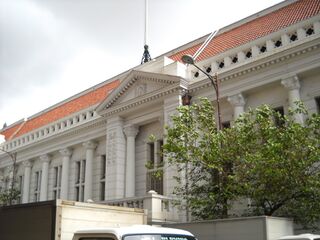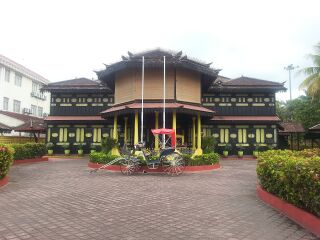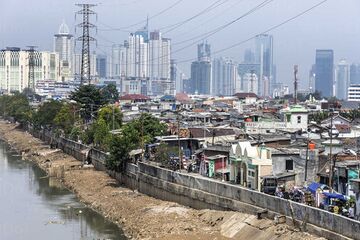Kéijō: Difference between revisions
| Line 148: | Line 148: | ||
{{Bar percent|[[Scattered Islands Frontier Creole]]|#d40000ff|34.28}} | {{Bar percent|[[Scattered Islands Frontier Creole]]|#d40000ff|34.28}} | ||
{{Bar percent|[[Taemhwanian Islander Sangunese]]|#FFA07A|22.75}} | {{Bar percent|[[Taemhwanian Islander Sangunese]]|#FFA07A|22.75}} | ||
{{Bar percent|[[ | {{Bar percent|[[Kahaldoches]]|#FFCBA4|14.68}} | ||
{{Bar percent|[[wikipedia:Hoklo people|Hoklo]]|#00aa88ff|6.25}} | {{Bar percent|[[wikipedia:Hoklo people|Hoklo]]|#00aa88ff|6.25}} | ||
{{Bar percent|[[Yapreayan people|Yapreayan]]s|#ffcc00ff|3.84}} | {{Bar percent|[[Yapreayan people|Yapreayan]]s|#ffcc00ff|3.84}} | ||
Revision as of 06:33, 19 April 2022

|
This article or section is a work in progress. The information below may be incomplete, outdated, or subject to change. |
| Kéijō 京城市 |
|
|---|---|
| City and administrative center | |
| View of Kéijō at night | |
| Country | |
| Entity | Oriental Hispanioéire Taemhwan Oriental Hispanioéire Taemhwan |
| Territorial unit | |
| District | Scattered Islands of the Ieu'ryïan Strait |
| District-administered city | Tromelin Atoll |
| Seat | Nichoume |
| Villages | 29 |
| Government | |
| • Body | |
| • Mayor | Miyako Hichidame |
| Population (RP 2617) | |
| • City and administrative center | 410,990 |
| • Urban | 519,000 |
| Time zone | Phinéas Padolski Time (UTC+5:20) |
| Postal code | 160207, 160208, 160220 – 160224, 160226 – 160228, 160231 – 160239, 160241 – 160244, 160247 – 160249, 160251 – 160253 |
| Area code(s) | (0)2 |
| ISO 3166 code | PH-OHT-02-01-01 |
Kéijō (Sangunese: 京城, translit.: Keijō?) is a city that serves as the capital and administrative center of the autonomous territorial unit of Taemhwanian Frontier Settlements Area, located in Tromelin Atoll, a most populous and densely populated atoll in the Oriental Hispanioéire Taemhwan and in Phinbella, and located in the Scattered Islands of the Ieu'ryïan Strait district. Kéijō is an offshore economic and cultural center in the autonomous entity Oriental Hispanioéire Taemhwan. Kéijō is close to the town of Panglima Bayu about 28 kilometers north via the Taihoku Channel, and close to the town of Flying Fish Cove about 10 kilometers to the west and close to Bassas da Ieu'ryïan about 38 kilometers southwest. The Kéijō city area has an area of 76.15 square kilometers, yet it is occupied by 410,000 inhabitants, while the population of Tromelin Atoll is 842,190 people. This offshore city is close to the entity boundary between Oriental Hispanioéire Taemhwan and the Free area of the Federation. Nichoume is the seat of the municipality and the largest commercial area. Kéijō is also one of the main tourist attractions in Oriental Hispanioéire Taemhwan and in Phinbella, and also it is becoming popular as a destination on summer holidays.
Kéijō is home to many squatter houses, various museums and shopping malls, it is also home to the Scattered Islands Frontier Creole community as well as the Taemhwanian music industry which has created a distinctive music genre called TC-pop. Kéijō is also home to the community’s traditional annual celebration of the Inaiko Tanko festival. Kéijō was once a village, however it has grown rapidly and will soon gain city status in RP 2618. Kéijō has also developed a light rail transit network as well as a new stadium. Since much of the city’s cultural heritage consists of cross-cultural mixing and the emergence of distinctive dialects or creoles, Kéijō is described as one of the most unique cities in Phinbella.
Rapid growth, traffic congestion, floods and rising water levels are major challenges for Kéijō. Kéijō was several times exposed to floods and storms.
Kéijō is served by a port that will connect the city with other atolls or islands as well as the Phinbellan Cyberian mainland (Cyber-Island Chain), and an international airport called Scattered Islands International Airport located northeast of the city.
Because of its location on the atoll, it was also given the title “Reef Heritage City” (Phineaner: Bandaraya Warisan Terumbu Karang) in RP 2612 by the Taemhwanian government, and due to its very distinctive cultural mixing, it was also given the title “The Phineonesian Big Easy” (Phineaner: Mudah Besar Phineonesia) in RP 2616. The Kéijō urban area, including Tromelin Atoll in particular, due to its growing population, the island area in Tromelin Atoll has expanded and several islands have merged with other islands following land reclamation since -15BP.
Etymology
History
Geography

Kéijō is located southwest of Saint-Thomas Island in Tromelin Atoll, right in the middle of the atoll. Geographically, the atoll has hilly areas on its two main islands, it also consists of small islands that are entirely inhabited and it is surrounded by low coral reefs. Tromelin Atoll where Kéijō is located is one of the largest atolls in Phinbella and the Phineonesian Confederation which is generally located in western Keltia. The urban area of Kéijō covers an area of 115.64 square kilometers (44.65 square miles), it includes the surrounding reclamation area that combines the two main islands, while the metropolitan area covers the entire Tromelin Atoll or the entire district of the Scattered Islands of the Ieu'ryïan Strait.
Kéijō is located about 42 kilometers north of Panglima Bayu, while the distance from the reef line of Tromelin Atoll to the Panglima Bayu coastline is about 28 kilometers, and about 32 kilometers from Bassas da Ieu'ryïan to the west. Meanwhile, Kéijō is also close to the Glorioso Islands about 66 kilometers from the southwest, Eureka Island about 64 kilometers from the southwest and John Ni Island about 55 kilometers from the southeast. It is also close to Martin-de-Viviès about 72 kilometers from the west.
Close to the city center about 8 kilometers, the highest point of Tromelin Atoll is Saint Thomas Hill at its height of 401 meters. Also close to the city center, which is about 6 kilometers to the south, is located on Kadok Island, a mountain called Kaki Shinjuku Hill with a height of 245 meters above sea level, and the hill is a tourist destination in Kéijō in addition to Saint Thomas Hill. In addition, several hills exist around Kéijō as well as on the two main islands in Tromelin Atoll. Kéijō is surrounded by skyscrapers and squatter houses. Indirectly, Tromelin Atoll is an atoll that has skyscrapers and many residential areas, especially on Saint Thomas Island and Kadok Island.
In addition to squatter housing in urban areas, Kéijō also has settlement areas on the water, where it is a fishing settlement and is located around the coast or close to its main port. Not excluded from that, due to being in the atoll, in the Kéijō city area also has a beautiful beach area that is a place for tourists from outside, one of which is the Big Bang Beach and Tetsuo Harano Beach which is located not far from the city center.
Kéijō including Tromelin Atoll is not spared from the land reclamation project, where it has increased the land area in this atoll from 165 square kilometers in -15BP to 395 square kilometers by RP 2625, an increase of about 16 percent. Usually some of these land reclamation projects involve the merging of small islands with major islands to form a large island and expand urban areas that serve as commercial and residential areas, as well as provide agricultural and livestock areas, it also expands port areas, coastal areas and built several resorts and recreation areas around Tromelin Atoll. Land reclamation in the Kéijō urban area generally uses polders, where the reclaimed area is covered and then pumped dry. This land reclamation also often took place on nearby islands or atolls simply because of expanding settlements and building naval bases. Tromelin Atoll is between the atolls and also cities that have reclamation areas besides Martin-de-Viviès, Providenciales, Springwind Islands, Cyborges, Plazas de Irian, Danville, Kota Hilir and Negara Awan.
Architecture
Kéijō is famous for its skyscrapers, apartments and squatter villages which are all built on the largest atoll in Phinbella, and is also very famous for its urbanization. The most important buildings built on or the islands are in terms of distinctive and unique architecture influenced from several cultures over time, mostly it is influenced by modern and contemporary architecture in addition to traditional architecture found in some squatter villages. The traditional architectural style of Kéijō has reflected the influence of Barbarite and Oranje Phineaner, Javanese, Xangese, Sangunese, Alexandrian, Martino (including Isleños), Nan'yōklander, Irish, Sino-Keltian, Arboric and Batavian cultures. Such influences have informed the Scattered Islands Frontier Creole community house architecture, and each of these community house architectures is varied and found in squatter areas and fishing settlements in Kéijō. The house is built of wood that is usually used to build traditional Barbarite and Oranje Phineaner houses, and the doors are made like those in traditional Sangunese houses, the roof shape is the same as the roof shape of Betawi houses, some are also influenced by the roof shape of Javanese joglo houses. Other housing styles such as creole cottages and flats are also available in the squatter villages. Another house style of the Creole community is strongly influenced by Sangunese and Betawi architecture.
Kéijō not too many colonial buildings and structures, buildings and structures influenced by Westerners architecture including Batavian, Alexandrian and Tellian architecture are found in this area of the city following the arrival of the community to Tromelin Atoll, mostly concentrated in the downtown area. Many buildings such as museums and places of worship are influenced by the existing architecture.
Urbanization in Kéijō has resulted in narrowing population growth resulting in land area expansion through reclamation, and indirectly it has shifted to modern and contemporary architecture since the -10BPs, most urban areas in Kéijō are filled with modern buildings and housing, as well as resorts that built along the coast. One of the areas with modern buildings in Kéijō is the Kéijō Central Business Zone and the San Sebastian Neighborhood. Kéijō has its own telecommunication tower, which it was built since RP 2613, and it became the first modern tower on top of the atoll.
Climate
| Kéijō | ||||||||||||||||||||||||||||||||||||||||||||||||||||||||||||
|---|---|---|---|---|---|---|---|---|---|---|---|---|---|---|---|---|---|---|---|---|---|---|---|---|---|---|---|---|---|---|---|---|---|---|---|---|---|---|---|---|---|---|---|---|---|---|---|---|---|---|---|---|---|---|---|---|---|---|---|---|
| Climate chart (explanation) | ||||||||||||||||||||||||||||||||||||||||||||||||||||||||||||
| ||||||||||||||||||||||||||||||||||||||||||||||||||||||||||||
| ||||||||||||||||||||||||||||||||||||||||||||||||||||||||||||
Although located in an atoll, Kéijō and the surrounding towns or islands (in the Scattered Islands district) have a subpolar oceanic climate (Köppen climate classification: Cfc) bordered by a subarctic climate, while the Phineonesia region is not nearby to polar regions other than Ross Dependency. This climate also occurs throughout the Territory of Taemhwanian Frontier Settlements Area, the northern part of the Taemhwanian Mainlands and the western area of Forajasaki. Usually Kéijō has cold temperatures and experiences snow every end and beginning of the year. The seasonal temperatures in Kéijō are moderate with its location off the coast and its distance from the ocean. The lowest average temperature is in January at almost −2 °C and the highest in July at almost 17 °C. The highest temperature recorded was at 28 °C in July RP 2613. However, the temperature in the summer in Kéijō which is not always hot does not prevent many people from visiting. Tromelin Atoll as well as some islands or atolls in Phinbella have a very distinctive climate compared to other islands or atolls in Micras which are familiar with a tropical climate in general.
The rainy season in Kéijō covers four months from December to March, and the snowfall season runs throughout the winter from November to April. May to October is the dry season in Kéijō with a very significant monthly rainfall of less than 50 millimeters. July and August deserve to be pure dry seasons as they have an average rainfall of less than 25 millimeters. As in most districts in the Taemhwanian Frontier Settelements Area, the peak rainfall in the wet season in January and February, the average monthly rainfall is 48.7 millimeters, it is also considered rain even though can be considered heavy, while the low point of the dry season in July and August, the average rainfall its monthly is 22.1 millimeters. Like some other cities, Kéijō also experiences the Cyberian monsoon, but Kéijō is known for experiencing strong winds of about 110 kilometers per hour which are strongest during the summer, however, the strong winds are most comfortable during the holiday season especially in late June to the end of August. Throughout the winter, Kéijō as well as Tromelin Atoll have or frequently experience floods and strong waves from the coast.
Demographics
| Year | Pop. | ±% |
|---|---|---|
| -25BP | 18,081 | — |
| -20BP | 29,901 | +65.4% |
| -15BP | 59,902 | +100.3% |
| -10BP | 80,012 | +33.6% |
| -5BP | 97,124 | +21.4% |
| RP 2600 | 121,879 | +25.5% |
| RP 2605 | 129,881 | +6.6% |
| RP 2610 | 312,881 | +140.9% |
| RP 2615 | 406,758 | +30.0% |
| RP 2617 | 410,990 | +1.0% |

Kéijō was home to 410,990 people at the RP 2617 census, while Tromelin Atoll had a population of 632,910 people. Kéijō has attracted people from all over Oriental Taemhwan and the Free area of the Federation, as well as from Barbara, the Pokok Emas Islands, Bahot and Ghawur, they come to Kéijō to find work there. As an atoll, Kéijō’s former population was a little over 18,081 people in -25BP and it shows 10 percent of the city’s population was born in Kéijō. In the early years, many Kéijō residents had moved to cities on the mainland, which made Kéijō’s population dwindling. Yet due to the arrival of new slaves from outside Tromelin Atoll and working there, it is very likely that the population of Kéijō will increase with marriages between locals, Westerners and their slaves. Its population has been stabilized by new low-density developments, an increase in immigrants seeking work and mixed marriages resulting in increased birth rates in Kéijō, one of which has contributed to the Yapreayan slave community. In -15BP, Kéijō’s population increased to 58,902 people, which has pushed Kéijō towards urbanization. The growing population of Kéijō has made Kéijō a densely populated urban area and the birth rate has increased by 20 to 50 percent, as a result of which several squatter houses as well as flats and apartments have been built around Kéijō since -15BP. Kéijō population data from -5BP showed an increased birth rate and 46.9 percent of the urban population was born in Kéijō. Inward migration to Kéijō tends to negate the impact of family planning programs in the era of urbanization in Kéijō. From RP 2600 to RP 2615, the Home Ministry of the Taemhwanian government compiled its own data which has increased since the need for identity cards in more than a decade.
Between -15BP and RP 2605, the population of Kéijō doubled compared to the period -25BP to -15BP, from 58,902 in -15BP to 129,881 people in RP 2605. During the period RP 2605 to RP 2610, the population increased annually by about 28 percent annually. At the RP 2610 census, it counted 312,981 people, compared to the government's estimate of 300,575 in RP 2608. Of Kéijō's population with five figures at the beginning, it has increased to six figures, and only about 67.8 percent of its population was born in Kéijō in RP 2615, it counts the legal population, while the population of Tromelin Atoll increased from 21,880 in -25BP to 617,981 people in RP 2615. It is predicted that Kéijō has a population, will reach 580,500 people by RP 2625, while Tromelin Atoll is projected to reach 680,000 people in the same year. Kéijō is the largest city in Oriental Hispanioéire Taemhwan compared to its capital Ҭvuҟovarь which has a population of 281,993 people.
In RP 2610, the raw birth rate was at 9.81 percent and the mortality rate was 4.13 percent. The population with college and university education accounted for 42.8 percent of the population, and the literacy rate stood at 98.31 percent of the population.







